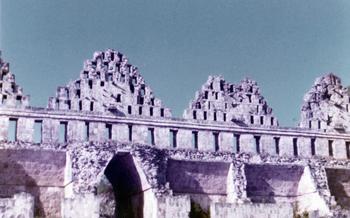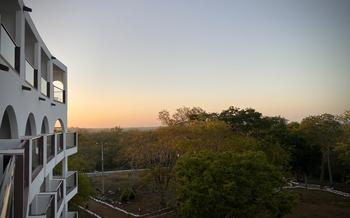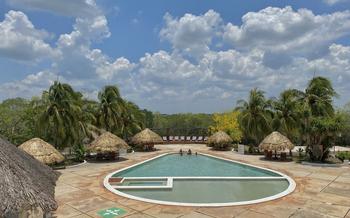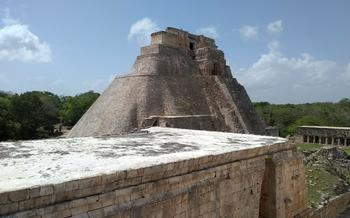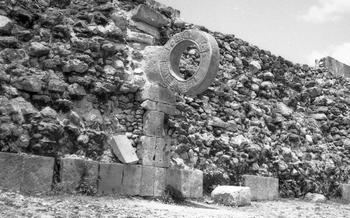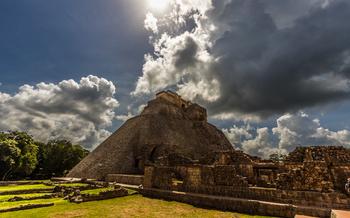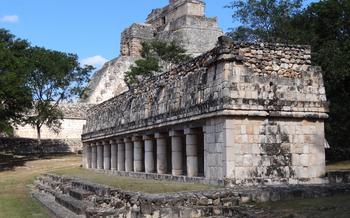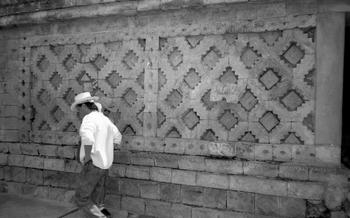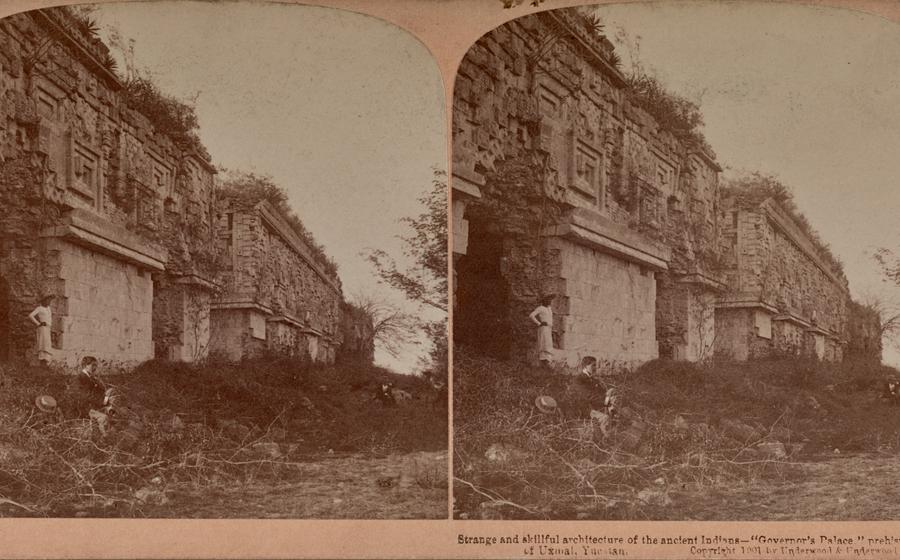
Governor's Palace, Uxmal
- Uxmal: A Journey to the Past
- Exploring the Governor's Palace
- Admiring the Palace's Facade
- Unveiling the Mystery of the House of the Turtles
- Discovering the Grand Pyramid
- Stepping into the Nunnery Quadrangle
- Exploring the Temple of the Magician
- Marveling at the Ball Court
- Uncovering the Secrets of the South Platform
- Immersing in the Museo del Mundo Maya
- Experiencing the Magic of the Light and Sound Show
- Discovering Local Delights at Uxmal's Restaurants
- Exploring Uxmal's Surroundings
- Insider Tip: Unveiling Hidden Gems
Uxmal: A Journey to the Past
Journey back in time as you explore the ancient city of Uxmal, a mesmerizing testament to the ingenuity and artistry of the Mayan civilization. Once a thriving metropolis, Uxmal boasts an impressive collection of well-preserved structures that showcase the architectural prowess and cultural significance of the Maya. Nestled in the heart of the Yucatán Peninsula in Mexico, Uxmal is easily accessible from major cities, making it a must-visit destination for history buffs, archaeology enthusiasts, and travelers seeking a glimpse into the enigmatic world of the Maya. Prepare to be captivated by the architectural marvels of Uxmal, where intricate carvings, towering pyramids, and grand plazas await your discovery.
Exploring the Governor's Palace
The Governor's Palace, known as the "Great House" or "Palace of the Governor," stands as a testament to the architectural prowess and power of the Mayan civilization. Constructed during the Late Classic period (600-900 AD), the palace served as the residence of the ruler of Uxmal and his entourage. It is one of the most iconic structures within the archaeological site and a must-see for visitors seeking to delve into the history and culture of the Maya.
The palace's architectural features are a testament to Mayan ingenuity. Its façade is adorned with intricate carvings and sculptures depicting Mayan deities, rulers, and scenes from their mythology. These carvings provide valuable insights into the religious and political life of Uxmal's elite. The palace's interior boasts a series of interconnected rooms and courtyards, each serving a specific function. From grand reception halls to private chambers, the palace's layout offers a glimpse into the daily life of Mayan rulers and their court.
Beyond its architectural grandeur, the Governor's Palace holds immense historical significance. It was the center of political and religious power in Uxmal and served as a stage for important ceremonies and rituals. The palace's presence reflects the sophisticated social and political organization of the Maya and their ability to construct monumental structures that served both practical and symbolic purposes.
Admiring the Palace's Facade
The facade of the Governor's Palace is a testament to the artistic prowess of the ancient Mayans. Intricate carvings and sculptures adorn the building's exterior, depicting a rich tapestry of Mayan mythology and history. Symbolic representations of deities, such as Chaac, the rain god, and Itzamna, the creator god, can be found throughout the facade, paying homage to the spiritual beliefs of the Maya.
Narrative panels, carved with scenes from Mayan life and history, further enhance the facade's visual appeal. These panels provide a glimpse into the daily lives, rituals, and ceremonies of the ancient Maya, offering a deeper understanding of their complex civilization. The intricate details and symbolism found on the facade of the Governor's Palace make it a true masterpiece of Mayan architecture and a must-see for anyone visiting Uxmal.
Unveiling the Mystery of the House of the Turtles
Amidst the architectural wonders of Uxmal, the House of the Turtles stands out with its enigmatic presence. This building, named for the turtle carvings that adorn its facade, holds significant historical and cultural value.
The House of the Turtles is believed to have been constructed during the Late Classic period of Mayan civilization, around the 8th or 9th century AD. Its architectural style reflects the influence of the Puuc region, characterized by intricate stone carvings and corbelled arches.
The building's most striking feature is the series of turtle carvings that line the upper facade. These turtles are depicted in various positions, including swimming, crawling, and resting. Some scholars believe that these carvings represent the Mayan creation myth, in which the world was created from the back of a giant turtle.
Others suggest that the turtles symbolize fertility and abundance, as turtles were considered sacred animals by the Maya. The presence of turtle carvings on the House of the Turtles may have been intended to invoke the blessings of the gods for a prosperous harvest and a healthy community.
Beyond its symbolic significance, the House of the Turtles also served a practical purpose. It is believed to have been used as an administrative building or a residence for high-ranking officials. The building's interior features several rooms, including a large central chamber, smaller side chambers, and a staircase leading to the upper level.
The House of the Turtles remains a captivating enigma, inviting visitors to explore its hidden meanings and marvel at the ingenuity of the Mayan builders. Its intricate carvings, rich symbolism, and historical significance make it a must-see destination for anyone interested in Mayan culture and architecture.
Discovering the Grand Pyramid
As you venture further into the heart of Uxmal, you will encounter the majestic Grand Pyramid, an architectural masterpiece that stands tall and proud against the backdrop of the Yucatán sky. This imposing structure commands attention with its sheer size, rising over 115 feet above the surrounding landscape. The Grand Pyramid is a testament to the architectural prowess of the ancient Maya, showcasing their mastery of construction techniques and their ability to create monumental structures that have withstood the test of time.
The pyramid's imposing height is matched by its intricate design and symbolism. Each level of the pyramid is adorned with intricate carvings and sculptures, depicting various aspects of Mayan mythology and history. These carvings provide valuable insights into the beliefs and rituals of the ancient Maya, offering a glimpse into their complex and fascinating culture.
The Grand Pyramid's religious significance is evident in its alignment with the movements of the sun and stars. The pyramid's orientation allows for precise observations of celestial events, such as the solstices and equinoxes, which were of great importance to the Maya. These astronomical alignments suggest that the pyramid served as a sacred platform for religious ceremonies and rituals, connecting the earthly realm with the heavens.
In comparison to other famous pyramids in the Mayan world, the Grand Pyramid of Uxmal stands out for its unique features and architectural style. While the pyramids of Chichén Itzá and Tikal are larger in size, the Grand Pyramid's intricate carvings and sculptures set it apart, showcasing the artistic and cultural achievements of the Puuc region.
Stepping into the Nunnery Quadrangle
The Nunnery Quadrangle, located in the heart of Uxmal's ancient city, presents a captivating enigma to visitors. Theories abound regarding its original purpose, with some suggesting it served as a convent for cloistered nuns or priestesses dedicated to religious rituals. Others believe it functioned as a palace for the ruling elite or as an administrative center for the city's governance.
Architecturally, the Nunnery Quadrangle showcases unique design elements that set it apart from other structures in Uxmal. Its four sides enclose a central courtyard, surrounded by a series of rooms and chambers. The facades are adorned with intricate carvings and sculptures, depicting scenes from Mayan mythology and daily life. The quadrangle's distinctive corbelled arches, a hallmark of Mayan architecture, create a sense of grandeur and spaciousness.
A notable feature of the Nunnery Quadrangle is its connection to the Governor's Palace. A series of doorways and passageways links the two structures, suggesting a close relationship between the occupants of both buildings. This proximity hints at the importance of the quadrangle within the political and religious hierarchy of ancient Uxmal.
Exploring the Nunnery Quadrangle offers a glimpse into the enigmatic world of Mayan culture. Its well-preserved architecture, intricate carvings, and intriguing history invite visitors to unravel the secrets of this ancient city and imagine the lives of its inhabitants.
Exploring the Temple of the Magician
Amidst the awe-inspiring structures of Uxmal, the Temple of the Magician stands as a testament to the architectural prowess and spiritual beliefs of the ancient Maya. Reaching a height of approximately 35 meters, this imposing pyramid dominates the northern end of the site. Its construction required immense engineering skill, as the pyramid was built without the use of mortar or cement.
The most distinctive feature of the Temple of the Magician is its unique shape, which resembles a magician's hat. This distinctive profile is believed to have inspired the pyramid's name. The temple's facade is adorned with intricate carvings depicting the rain god Chaac, a deity of immense importance to the Maya. These carvings showcase the Maya's reverence for water and agriculture, essential elements for their survival in the Yucatán Peninsula's harsh environment.
The construction of the Temple of the Magician is shrouded in mystery, with various theories attempting to explain its purpose. Some believe it served as a burial site for an important ruler or priest, while others suggest it was a place of astronomical observation. Recent excavations have revealed a secret chamber within the pyramid, containing a rich collection of artifacts, including jade, pottery, and human remains. These discoveries have shed new light on the significance of the temple and the rituals performed within its sacred chambers.
Compared to other Mayan pyramids, the Temple of the Magician stands out for its unique architectural features and the enigma surrounding its construction and purpose. Its towering height, intricate carvings, and hidden chamber make it a captivating structure that continues to intrigue and inspire visitors to Uxmal.
Marveling at the Ball Court
Uxmal's ball court is a testament to the cultural and ritual significance of the ancient Mayan ball game. Perfectly aligned with the cardinal points, this impressive structure showcases the Mayans' advanced knowledge of astronomy and geometry. The sloped side walls, with their intriguing niches and elaborate carvings, add to the court's grandeur. As you step into the arena, imagine the electrifying atmosphere of a Mayan ball game, where skilled players maneuvered a heavy rubber ball using only their hips and elbows, aiming to pass it through the stone hoops fixed high on the side walls. The game was not merely a sport but a sacred ritual, deeply intertwined with Mayan mythology and cosmology. The outcome of the game was believed to have far-reaching implications, influencing everything from agriculture to warfare.
Uncovering the Secrets of the South Platform
The South Platform, known as the "Great Platform," is an intriguing and enigmatic structure within the archaeological zone of Uxmal. It is a massive raised platform, measuring approximately 200 meters long, 150 meters wide, and 12 meters high. Despite its impressive size, the exact purpose of the South Platform remains a mystery.
Archaeologists have proposed various theories regarding its function. One suggestion is that it served as a ceremonial center, with rituals and ceremonies taking place on its elevated surface. Another theory proposes that it functioned as a marketplace or trading center, where merchants gathered to exchange goods and products. Its strategic location within the city and the presence of nearby residential structures support this hypothesis.
The South Platform is further distinguished by its architectural elements and symbolism. It features several structures, including small temples, platforms, and staircases. These structures are arranged in a specific layout, creating a complex and visually striking composition. The platform is also adorned with intricate carvings and sculptures, including representations of Mayan deities, animals, and geometric patterns. These decorative elements provide valuable insights into the religious and cultural beliefs of the ancient Maya.
Exploring the South Platform offers visitors a glimpse into the enigmatic side of Uxmal. Its imposing size, unique structures, and symbolic carvings invite visitors to ponder the mysteries and unanswered questions that surround this ancient Maya site.
Immersing in the Museo del Mundo Maya
A visit to the Museo del Mundo Maya is a must for anyone seeking a deeper understanding of Uxmal and the broader Mayan civilization. This state-of-the-art museum houses a diverse collection of artifacts, sculptures, and interactive exhibits that bring the rich history and culture of the ancient Maya to life.
As you step inside the museum, you'll be greeted by a timeline of Mayan history, providing context for the significance of Uxmal within the broader Mayan civilization. Immerse yourself in the captivating exhibits that showcase Mayan art, architecture, and daily life, offering insights into their advanced knowledge of astronomy, mathematics, and writing systems.
Through interactive displays and multimedia presentations, the museum invites you to engage with Mayan culture in a dynamic and engaging way. Learn about their sophisticated agricultural practices, trade networks, and religious beliefs that shaped their worldview. The museum also highlights the ongoing efforts to preserve and protect Mayan heritage in the modern era.
A visit to the Museo del Mundo Maya is an essential complement to your exploration of Uxmal. It provides a deeper understanding of the ancient Maya's ingenuity, creativity, and enduring legacy, ensuring a truly enriching and memorable experience.
Experiencing the Magic of the Light and Sound Show
As darkness descends upon Uxmal, a captivating spectacle unfolds before your eyes. The ancient ruins are transformed into a canvas of light, sound, and storytelling, immersing you in the rich history and legends of the Mayan civilization. This awe-inspiring light and sound show breathes new life into the ancient stones, transporting you back in time to witness the grandeur of Uxmal's past.
Through vibrant projections, intricate lighting effects, and a symphony of sounds, the show narrates the fascinating tales of Mayan gods, kings, and their extraordinary achievements. Watch as mythical creatures come to life, casting their shadows upon the ancient structures, and listen as the echoes of ancient rituals and ceremonies reverberate through the night.
This immersive experience takes you on a journey through the rise and fall of Uxmal, showcasing the ingenuity, artistry, and spiritual beliefs of its people. As the show reaches its climax, you'll feel a sense of awe and wonder as the ruins are illuminated in a breathtaking display of light, leaving you with an unforgettable memory of your visit to this ancient Mayan city.
Discovering Local Delights at Uxmal's Restaurants
Uxmal offers a delightful culinary experience for visitors, showcasing the authentic flavors of Mayan cuisine. From traditional dishes to local markets, there are plenty of options to satisfy every palate.
One must-try is the cochinita pibil, a slow-roasted pork dish marinated in achiote paste and wrapped in banana leaves. Another local delicacy is papadzules, a dish consisting of corn tortillas filled with eggs, pumpkin seeds, and a tomato-based sauce.
For a more immersive experience, visitors can head to the local markets. These vibrant marketplaces offer a wide variety of fresh produce, spices, and traditional dishes. Street food vendors also line the streets, offering a tempting array of snacks and treats.
To truly savor the local flavors, it is recommended to venture beyond the main tourist areas and explore the nearby villages. Small restaurants and family-run eateries often serve authentic Mayan dishes using traditional recipes passed down through generations.
When dining in Uxmal, remember to embrace the local customs. It is customary to greet the restaurant staff with a friendly "buenos días" or "buenas tardes." Take your time to enjoy the meal, as it is considered rude to rush. And don't forget to indulge in a refreshing agua fresca, a traditional Mexican fruit-based drink, to complement your meal.
Exploring Uxmal's Surroundings
Beyond the confines of Uxmal's main ruins, the region offers a wealth of additional attractions that are well worth exploring. History enthusiasts can delve deeper into the Mayan civilization by visiting nearby archaeological sites such as Kabah, Sayil, and Labná, each possessing its own unique charm and architectural wonders. Immerse yourself in the natural beauty of the Yucatán Peninsula by exploring cenotes, underground rivers, and caves that provide a refreshing respite from the tropical heat. For those seeking adventure, there are opportunities for hiking, biking, and zip-lining through the lush jungle landscapes that surround Uxmal. Whether you prefer history, nature, or adventure, the surrounding area offers something for every traveler.
Insider Tip: Unveiling Hidden Gems
Beyond the main attractions, Uxmal holds many hidden treasures waiting to be discovered. Explore the lesser-known structures like the Temple of the Old Woman or the House of the Birds, each with its unique architectural features and historical significance. Venture into the nearby villages of Santa Elena or Muna to immerse yourself in the authentic Mayan culture, where you can witness traditional ceremonies, learn about local crafts, and savor delicious homemade dishes. Seek guidance from local experts and guides who can lead you to hidden cenotes, secluded ruins, and breathtaking viewpoints. These insider tips will transform your visit into an unforgettable and enriching experience, allowing you to uncover the secrets of Uxmal that lie beyond the beaten path.
